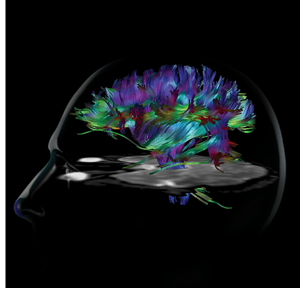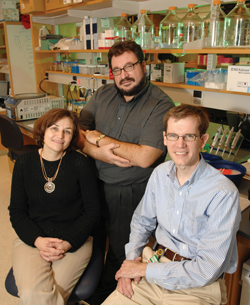
image courtesy VUIIS/Medical Art Group
VUMC Reporter Series: Psychiatry researchers shed new light on biology of brain diseases

Department of Psychiatry investigators, from left, Christine Konradi, Ph.D., Karoly Mirnics, M.D., and Jeremy Veenstra-Vander Weele, Ph.D. (photo by Neil Brake)
Mental illnesses and psychiatric disorders are some of the most costly illnesses to society — yet the causes remain elusive and finding the appropriate treatments is often a game of trial and error.
Unlike with cancer or heart disease, people with mental illness have almost normal life expectancy, yet are often so debilitated by their disease that they cannot work.
“That's a tremendous economic burden,” says Karoly Mirnics, M.D., associate professor of Psychiatry.
Researchers in Vanderbilt's Department of Psychiatry hope to help alleviate this burden by probing the biology of psychiatric illness and applying this knowledge to improving diagnosis and treatment.
Traditionally, psychiatry has put disorders in certain boxes, says Mirnics, whose research interests span autism to Alzheimer's disease. “But in real life, there are many continuities between symptoms of the disorders. And we want to understand what is common — and what is different — between human brain disorders.”
To accomplish this ambitious goal, Mirnics is analyzing gene expression patterns in human postmortem brain samples to identify factors that underlie various aspects of human brain disease. He then applies the results to develop animal and cell culture models to mimic different aspects of the disease for further study, “feeding this information back-and-forth and trying to figure out as many pieces to the puzzle that we can,” he says.
With this approach, Mirnics and colleagues have identified a surprising immune system activation in the brains of patients with schizophrenia and autism. Recently, he and colleagues at the California Institute of Technology reported that a single injection of an immune system protein, interleukin-6 (IL-6), during mid-gestation in mice causes behavior and tissue abnormalities reminiscent of schizophrenia and autism in the offspring. Blocking IL-6 action prevents the behavioral deficits, suggesting that this immune system protein may mediate the effects of maternal immune activation on the developing brain and predispose the fetus to developing schizophrenia and/or autism.
These experiments highlight Mirnics' research philosophy of “data-driven research.”
“Traditionally, you have a hypothesis, and you either prove or disprove it. However, this is changing by the emergence of new, high-throughput technologies,” Mirnics says. “For example, DNA microarrays allow us to examine expression of the whole human genome simultaneously in a single experiment, allowing us to do hypothesis-free, or data-driven, research…letting the data tell me where the differences are.”
This philosophy — of following unexpected leads — also guides the research of Christine Konradi, Ph.D., professor of Psychiatry and Pharmacology.
Konradi, who came to Vanderbilt in 2006, has followed such leads throughout her career — from her beginnings studying dopamine system dysfunction in Parkinson's disease, to drug abuse and her current research on bipolar disorder and schizophrenia.
While at the McLean Hospital at Harvard Medical School, Konradi wanted to analyze gene expression patterns in the brains of schizophrenia patients. But the Harvard Brain Bank, which provided the tissue, required her to also include patients with bipolar disorder in her study.
To her surprise, she found incredible changes in a specific set of genes in bipolar brains. The expression of these genes, which is involved in making the cellular “energy” known as ATP, was decreased in the hippocampus — a brain region involved in learning and memory.
“I liken it to your brain running on empty,” she says. “You don't have the energy reserves you need to draw on in times of stress.”
This finding seemed to correspond with the clinical observation that bipolar disorder often reveals itself during times of intense stress. But since measuring these changes in a living person's brain is impossible, Konradi found another readily available tissue that could be used for diagnostic purposes: white blood cells.
In the white blood cells of patients with bipolar disorder, Konradi found deficiencies similar to those in the postmortem brains. When the cells were deprived of glucose — the sugar converted by cells into energy — the cells of bipolar patients were unable to “turn up” the expression of genes critical to energy production, a response that the cells of control subjects readily exhibited.
“That indicates that these cells do not adjust to stress in a healthy way. Interestingly, in patients, stress can trigger bipolar episodes and it tends to worsen the disorder,” she explains. “In a way, we recreated, in a cellular model, what we see in patients.”
Konradi hopes that this finding will lead to a blood test for bipolar disorder that might indicate the most effective course of treatment for individual patients.
“A blood test will have only limited impact for a patient unless it can be linked to a particular therapy,” she says.
Both Konradi and Mirnics note that their research is greatly enriched by the psychiatry department's close collaboration with other departments and centers, including the Vanderbilt Kennedy Center for Research on Human Development.
This, along with the Kennedy Center's strength in autism research, also appealed to Jeremy Veenstra-Vander Weele, M.D., instructor in Clinical Psychiatry, when he was considering expanding his research on the genetic factors underlying autism.
He came to Vanderbilt as a postdoctoral fellow to work in the Center for Molecular Neuroscience with Randy Blakely, Ph.D., and James Sutcliffe, Ph.D., who have identified rare variants in the serotonin transporter gene in autism. He is now characterizing the effects of two of these variants in mice.
These variants are rare, so they are unlikely to be the sole factor in autism.
“We don't expect to find a simple answer,” he says. “We hope, though, that these rare variants will help us understand the impact of altered serotonin system function in 25 percent of children with autism.”
Like Mirnics and Konradi, Veenstra-Vander Weele will work back-and-forth between human and animal studies. While behavioral therapies have been the mainstays of autism treatment, Veenstra-Vander Weele sees exciting new opportunities to begin translating the basic science revelations on autism into clinical applications. He is currently working on a collaborative project between psychiatry, the Kennedy Center, and pediatrics to develop medication trials for autism.
“I want to be involved in translating basic science findings into new treatments for autism,” he says.













